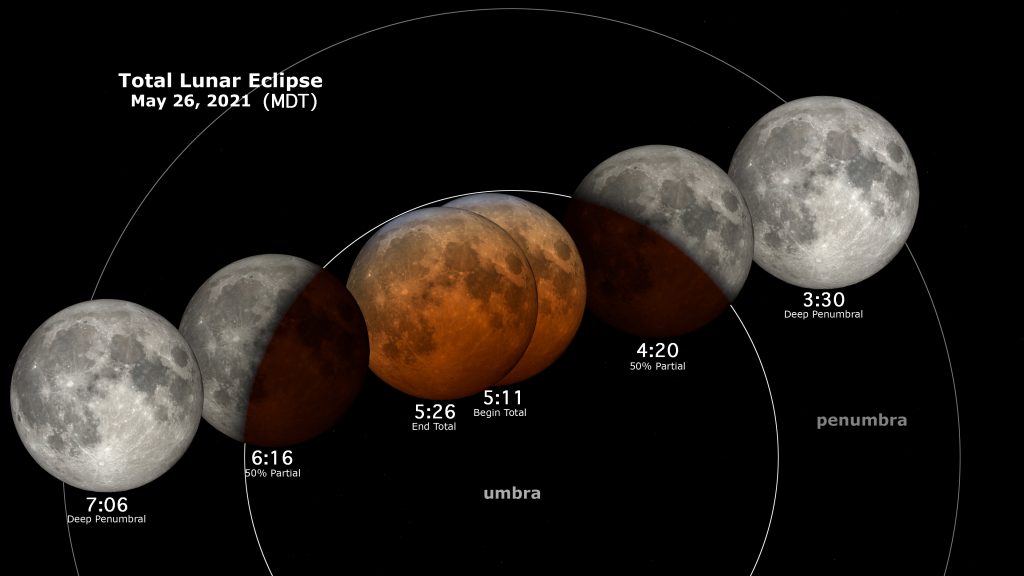Sky Report: May 24 – May 30

This week’s main event is a total eclipse of the moon on the morning of Wednesday, May 26. A total eclipse of the moon happens when the full moon moves through the shadow of the earth and grows dark. Everyone on the side of the earth that faces the moon can watch the eclipse simultaneously. This eclipse is visible from all of North and South America except the eastern portions and most of the Pacific Ocean. We’ll see the moon set while the eclipse is still in progress.
Eclipses happen in stages; follow the diagram. The moon enters the outer part of the earth’s shadow (penumbra) at 2:46 am MDT but you won’t notice the moon’s left edge darken until about 3:45 when the moon enters the inner, dark part of the shadow – the umbra. The moon is fully within the umbra and the eclipse is total only from 5:11 to 5:26 am. At 6:16 the moon is half-way out of the umbra, but the moon sets moments later, while still partially eclipsed – an interesting photo opportunity.
The moon’s orange color comes from sunlight from all the earth’s sunrises and sunsets that are refracted around the edge of the earth and onto the moon.
Excellent visualizations are at https://svs.gsfc.nasa.gov/4903.
Venus is very low in the west-northwest during early evening twilight.
I wrote that last week was the last week to see Mercury, but it will be tempting to try on the 28th when Mercury passes slightly less than ½° left of the planet Venus. The problem is that Mercury is such a slim crescent that it’s only 1/200th as bright as Venus plus you need to look for it with a telescope in early twilight, 45 minutes after sunset, when it’s only 5° high. It’ll certainly be a challenge.
Look for faint Mars once the sky is dark 1/3 of the way up the western sky amidst the stars of Gemini.
Jupiter and Saturn are in the morning sky. Jupiter is brilliant and Saturn is 1/15 as bright and to the right of Jupiter. A nova that brightened and then faded in March has, to everyone’s astonishment, brightened again, and at midmonth was an easy binocular object. Who knows what it will do next! Look for it in Cassiopeia near the star cluster M53; a great reference with finder charts is at https://skyandtelescope.org/astronomy-news/nova-in-cassiopeia-brightens-suddenly/.
The Sky Report is presented as a public service by the Stellar Vista Observatory, a nonprofit organization based in Kanab, Utah, which provides opportunities for people to observe, appreciate, and comprehend our starry night sky. Additional information is at www.stellarvistaobservatory.org. Send questions and comments to
John@StargazingAdventures.org.






Comments are closed.